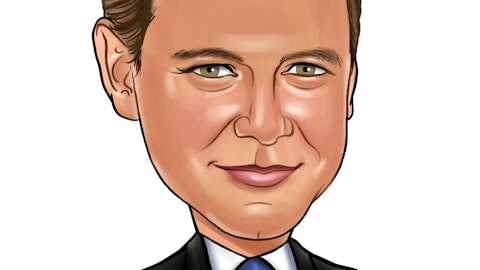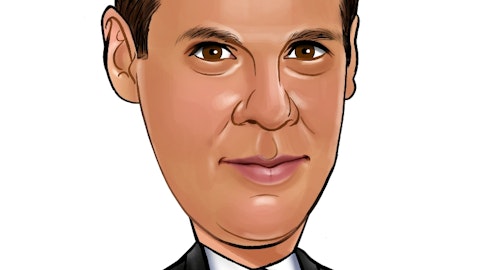Mirum Pharmaceuticals, Inc. (NASDAQ:MIRM) Q4 2022 Earnings Call Transcript March 8, 2023
Operator: Good afternoon. Thank you for attending the Mirum Pharmaceuticals Fourth Quarter and Year-End 2022 Financial Results and Business Update. My name is Matt, and I’ll be your moderator for today’s call. . I’ll now like to turn the conference over to our host, Andrew McKibben, Vice President of the Investor Relations and Finance. Andrew, please go ahead.
Andrew McKibben: Thanks, Matt, and good afternoon, everyone. I’d like to welcome you to Mirum Pharmaceuticals fourth quarter and full year 2022 conference call. I’m joined today by our President and CEO, Chris Peetz, our Chief Operating Officer, Peter Radovich, our Head of R&D, Pam Vig, and our CFO, Ian Clements. Earlier today, Mirum issued a news release announcing the company’s results for the fourth quarter and full year 2022. Copies of this news release and SEC filings can be found in the Investors Section of our website. Full details on updates from the quarter can be found in our news release and 10-K issued today. Before we begin, I’d like to remind you that during the course of this conference call, we’ll be making certain forward-looking statements about Mirum and our programs based on management’s current expectations, including statements regarding Mirum’s business plans, development programs, strategies, prospects, market opportunities and financial forecasts and guidance.
Mirum is under no duty to update these statements, and they are subject to numerous risks and uncertainties, and actual results could differ materially from the results anticipated by these statements. Investors should read the risk factors set forth in Mirum’s 10-K for the year ended December 31, 2022, and any subsequent reports filed with the SEC. With that said, I’d like to turn the call over to Chris. Chris?
Chris Peetz: Thank you, Andrew. And good afternoon to everyone joining us on the call today. In 2022, Mirum made remarkable progress, growing into our leadership position as a high-growth rare disease company focused on commercializing life-changing medicines. And while we are all excited about our Q4 quarter-over-quarter sales growth of 48%, we are just getting started. Our clinical, regulatory and business achievements during the year with net product sales for LIVMARLI of $75 million, provide a strong base from which we will rapidly grow our business. We have put in place a 5-part strategy to become a global leader in rare disease. First, build on the successful launch of LIVMARLI in Alagille syndrome in the U.S. LIVMARLI is the first and only treatment in Alagille syndrome to provide early improvements with long-term impact.
And we are still early in making LIVMARLI available to the addressable Alagille syndrome patient population. In the second half of last year, we expanded our field presence and investment in the U.S., and now anticipate 50% growth in U.S. LIVMARLI sales in 2023. This is driven by the Mirum team and the tremendous potential of LIVMARLI for patients, which was highlighted this year by data showing that in Alagille syndrome patients showing with LIVMARLI, 88% of them remain event-free at 6 years. Now second, grow LIVMARLI in markets outside the United States. Following European approval in December, we have already launched in Germany, with France to follow shortly and further launches around the globe later this year and in 2024. Third part of our strategy, expand the label for LIVMARLI.
At the end of last year, we presented LIVMARLI PFIC Phase III data. This is the largest study conducted in this devastating disease, covering the widest range of PFIC types. In addition to impressive reductions in serum bile acid and pruritus, we saw placebo-controlled improvements in various markers of liver health, namely bilirubin and growth, the first I’ve seen is reported for IBAT clinical studies. We have submitted our sNDA and are excited about bringing the strong data profile to prescribers and patients. On our third potential indication for LIVMARLI, we have also made good progress in the EMBARK study in Biliary Atresia and expect to announce data in the second half of this year. Fourth, apply our expertise in IBAT inhibition to expand into adult cholestatic liver disease.
Building on earlier IBAT inhibitor data in primary sclerosing cholangitis and primary biliary cholangitis, we are conducting potentially pivotal studies for volixibat in these two underserved indications. And finally, the fifth part of our strategy, expand our development pipeline for business development activities. We are evaluating a number of interesting opportunities across rare and orphan diseases to leverage Mirum’s industry-leading rare disease capabilities. We entered 2023 with great momentum, and I am excited by what the Mirum team can achieve in the near future, providing patients with life-changing medicines that they’ve been waiting for. And with that, I’ll pass the call over to Peter to discuss our commercial business in more detail before Pam gives an R&D update.
Peter?

Photo by Myriam Zilles on Unsplash
Peter Radovich: Thanks, Chris. We are pleased with the $27.9 million in LIVMARLI net product sales in the fourth quarter of 2022, which represents a 48% growth over the third quarter. Additionally, we reported $75.1 million in LIVMARLI net product sales for the full year 2022, which included $68 million in the United States and $7.1 million from international markets. Needless to say, we are thrilled with LIVMARLI’s performance in its first full year on the market, which represents one of the strongest rare pediatric launches in the industry. Now first, some comments on the U.S. business. The growth we saw in Q4 was driven by more new patient starts and a consistent refill pages, which were both a direct result of our commercial team’s strong execution.
We estimate that about 20% of currently diagnosed and addressable patients with Alagille syndrome in the United States have received LIVMARLI since launch. And as the results reported today demonstrate, our commercial team has been highly effective at driving the LIVMARLI launch further into the addressable market, and we remain confident in continued growth going forward, consistent with our guidance that 2023 LIVMARLI U.S. sales will grow by 50%. Now turning to international. The $7.1 million in 2022 sales was predominantly in Q4 and came from partner markets in Eastern Europe and the Middle East where Mirum’s distribution partners were able to engage in preapproval commercial access programs. The Q4 international sales number included an inventory build as a result of full-year product orders for identified patients in these partner markets.
Looking forward to 2023, we expect to see continued demand growth and sales contribution from partner markets in Eastern Europe and the Middle East, as well as new partner markets coming online in Latin America and Asia, including Korea, where LIVMARLI was recently approved. European commercialization has commenced following the December 2022 European Commission LIVMARLI approval. In early 2023, Germany became the first European country to launch and is off to a great start in the initial weeks out of the gate. In France, our pre-approval access program for LIVMARLI was recently approved, enabling access to commercial LIVMARLI before full reimbursement. Beyond Germany and France, we expect other Western European countries to launch upon completion of pricing and reimbursement discussions later this year and into 2024.
Finally, our LIVMARLI marketing application is under review in Canada, which, if approved, would enable a launch later this year. In summary, LIVMARLI is the first and only treatment for Alagille syndrome that provides early improvements with long-term impact on event-free survival. With approximately 600 Alagille patients treated globally to-date clinicians have gained familiarity with and confidence in LIVMARLI’s robust clinical profile as well as its exceptional access and patient support. We believe this will propel a continued growth story for the Alagille syndrome launch going forward. On that note, I’ll turn the call over to Pam. Pam?
Pamela Vig: Thank you, Peter. 2022 was an outstanding year for our clinical team as we presented meaningful data, supporting both our commercial stage and pipeline programs. At the end of last year, we presented groundbreaking Phase III data for LIVMARLI and PFIC, in which LIVMARLI drove a statistically significant reduction in pruritus and serum bile acids across the broadest genetic PFIC type study to-date, showing a magnitude of treatment effect, which is approximately double from previous studies and exceeded our expectations. Notably, the majority of patients also achieved serum bile acid reductions below the threshold that is associated with transplant-free survival. And furthermore, LIVMARLI also drove early and significant placebo-controlled improvements in growth as well as in bilirubin, suggesting an improvement in the underlying liver health of these patients.
And as a reminder, bilirubin is an important indicator of disease progression in cholestatic disease and MARCH is the first study to demonstrate statistically significant differences in bilirubin versus placebo in PFIC. And it’s remarkable that this was observed with only 6 months of treatment. While these unprecedented clinical effects from the MARCH-PFIC study across broad genetic types situates LIVMARLI in a very strong position. And we are thrilled to deliver LIVMARLI to the broader PFIC population and regulatory approval. Now as we look to biliary atresia, the bilirubin and serum bile acid reductions observed in PFIC are very encouraging. Both of these markers, particularly bilirubin, are strong prognostic indicators of disease progression and our primary endpoint will measure the 6-month change in billing from baseline.
We look forward to announcing this top-line data from the Phase IIb EMBARK study in the second half of this year. In the adult cholestatic indication, there is a similar significant unaddressed burden of cholestatic pruritus which is associated with the buildup of toxic bile acids severely affecting quality of life in these patients. And in the setting of both CSC and PBC, about over 60% of patients have pruritus of which about 80% or more are being treated with off-label and anti-secrete medications that are largely ineffective or offer only partial response. And year-to-date the new options as highlighted by a PSC survey we presented last year were 75% of patients using 2 or more medications described only partial order release. Given the significant burden of these diseases, we’re really excited to continue advancing volixibat in PSC and PBC with interim analysis expected later this year.
And lastly, I’m really proud of our team’s academic and collaborative efforts as well as our continued scientific leadership, which was showcased throughout 2022 through our congress presentations and a number of publications characterizing the benefits of LIVMARLI in pruritus and beyond, mirroring what we’re hearing from the real-world experience. And 2023 is expected to be another outstanding year. And with that, I’ll turn the call over to Ian to review our financial results. Ian?
Ian Clements: Thanks, Pam. The press release and 10-K filed earlier today provide a full financial update. However, I’ll call out a couple of the highlights here. First, from a revenue perspective. Total revenue for the year ended December 31, 2022, was $77.1 million, including license revenue of $12 million or $2 million versus total revenue of $19.1 million for 2021. Of note, this is slightly higher than the $76 million preliminary estimates we announced back in January. Turning to operating expenses. Total operating expenses, including cost of sales for the year ended December 31, 2022 were $208.3 million versus $192.6 million for the prior year. Mirum remains well funded with over 3 years of runway. And at the close of the year, we had $251.7 million on the balance sheet.
Additional details on all of our operating expenses and our cash balance are provided in our 10-K filing. Overall, our financial position is strong and supports our continued growth and value creation across both our global commercial business, and development pipeline. With that said, I’ll turn the call back over to Chris. Chris?
Chris Peetz: Thanks, Ian. Mirum is poised for continued growth throughout the years ahead as we execute on commercial, regulatory and clinical value creation. We’re in the midst of a strong launch in Alagille syndrome, growing the U.S. business while launching in Europe and partner markets and unlocking expansion opportunities for LIVMARLI and volixibat ahead of us. We expect 2023 will be a catalyst-rich year. In addition to the continuing strong commercial growth for LIVMARLI adoption in Alagille syndrome, we have the potential PFIC label expansion and data readouts for our pipeline programs as we get further into the year. True to our name, Mirum, which comes from the Latin word for remarkable, our recent accomplishments and anticipated growth ahead in 2023 are full of unique potential as we work to bring important new medicines to patients around the world. And with that, operator, please open the call for questions.
See also 11 Best Cryptocurrencies to Invest In for Beginners and 15 Countries with Highest Inflation Rates.
Q&A Session
Follow Mirum Pharmaceuticals Inc. (NASDAQ:MIRM)
Follow Mirum Pharmaceuticals Inc. (NASDAQ:MIRM)
Receive real-time insider trading and news alerts
Operator: Absolutely. The first question is from the line of Jessica Fye with JPMorgan. Your line is now open.
Jessica Fye: I was hoping you could provide a little bit of a framework for how to think about Europe sales this year. I’m not sure if there’s anything you can provide on that front? And then, second, I think in prepared remarks, you mentioned that 20% currently diagnosed and addressable patients have received LIVMARLI since launch. Can you talk through how we get to $500 million peak sales for LIVMARLI in Alagille in the U.S. based on what we saw for 4Q sales. In particular, I’m sort of curious what market share is assumed in that forecast. And also how much upward drift in price per patient is anticipated due to growth? Thank you.
Chris Peetz: Thanks, Jessica, for the question. I give a couple of inter-comments, and I’ll let Peter speak to some of the details in particular on how Europe launch will roll out and some of the market dynamics in the U.S. But I think just pointing to some pretty quick and easy math on Q4 U.S. revenue is a little bit of rounding to this, but that’s pretty close to a $100 million run rate at 20% penetrated. I think you can kind of get the picture of how that lines up with the $500 million or greater market opportunity that we talk about for the U.S. With that kind of just a quick backdrop on the U.S., I’ll hand over to Peter to maybe pick into the Europe question.
Peter Radovich: Sure. Happy to comment on that. And I think as you think about the international piece for LIVMARLI in 2023, it’s probably like 3 components to think about. The key driver will be Germany. As I mentioned, we’re in the market in Germany now, had a really strong start in the first handful of weeks. That’s really the one country will be it where we have kind of access to the full health care system with full reimbursement. The second kind of bucket for 2023 is really name patient sales program or pre-reimbursement approval programs. I mentioned we have one in France that’s opening up with commercial LIVMARLI, there’s also a couple of others potentially in Western Europe as well as partner markets. Those kind of programs are what drove our Q4 2022 number and opportunities to participate in those programs, even in new geographies of Latin America.
Those are a little bit less predictable. We have clear visibility to high unmet medical need. We hear from clinicians about patients who are really, really interested in LIVMARLI. So at the clinical side is high visibility, but it’s really kind of country-specific kind of pricing reimbursement mechanisms that have to be navigated there. So that’s the second bucket. And then I think the third bucket I’d kind of call out for 2023 is new country launches. So in Western Europe, we might have some new countries coming on at the end of the year or into 2024, depending on how pricing reimbursement timelines go. I mentioned Canada which have approved by Health Canada, could support a launch with contribution from the private market to Canada at the end of the year.
So there’s a cup in that third bucket, there’s a couple markets where you could start to see contribution in late ’23, but really more likely in 2024.
Operator: The next question is from the line of Mani Foroohar with SVB Securities. Your line is now open.
Mani Foroohar: A quick question more on the pipeline. As we think about the sort of portfolio of readouts that you’re coming throughout this year in Phase II, on what time horizon should we expect to get a little more clarity on what is and is not pivotal, just relative to when we’re getting the data, I know there’s a little bit of uncertainty around exactly what a pivotal endpoint might be, for example, in biliary atresia, et cetera. How should we think about the gap between data and when we’ll get a little bit of clarity on what an approval endpoint is or isn’t?
Chris Peetz: Thanks for the question, Mani. I can touch on a little bit of context to put on these readouts. And I’d point out that biliary atresia for LIVMARLI, you should think about it differently from the volixibat interims. And first commenting on the biliary atresia readout, we won’t know at the primary analysis readout later this year. That’s going to involve some conversations with FDA interpretation of the data, building our case to understand what the next step is for that program, whether it’s putting together a submission or planning for another study. The volixibat program, though, these studies are very different in their positioning as potentially pivotal studies. We have already aligned with FDA on using pruritus as the registrational endpoints and the analysis plans for both of these studies.
So think of these upcoming interims as really the dose selection to move into the pivotal portion. So when each volixibat study gets to its interim analysis, they essentially convert into pivotal studies for that adaptive part 2. So we know once we cross that interim as long as the study is continuing. It is a pivotal study in all kind of forms and the input from FDA that you want for a pivotal study.
Operator: The next question is from the line of Josh Schimmer with Evercore.
Josh Schimmer: Great. First, for the commercial spend, how should we think about the step-up as you add new indications to the franchise, we had LIVMARLI or volixibat? And then for either product, but I guess, LIVMARLI, any updates or progress identifying a path forward for the ICP indication?
Chris Peetz: Great. Thanks for the question, Josh. I’ll pass it over to Peter to talk a little bit about commercial spend across the indications and products. But I can comment on the ICP question in the interim. Really interesting data that came out of the OHANA study, albeit very small patient numbers that we were looking at. You can tell that volixibat is active for these patients. It addresses the pruritus, just a near and possible setting to conduct robust clinical studies in. So we are seeing interest in potential investigator-sponsored approaches. We’ll continue to explore that. But kind of until those come together, don’t have a formal update on the ICP program. Peter, do you want to comment on commercial investment?




